Zinc-Air Battery Market Size and Trends
The zinc-air battery market is estimated to be valued at USD 2.35 Bn in 2025 and is expected to reach USD 3.54 Bn by 2032, growing at a compound annual growth rate (CAGR) of 6.0% from 2025 to 2032.
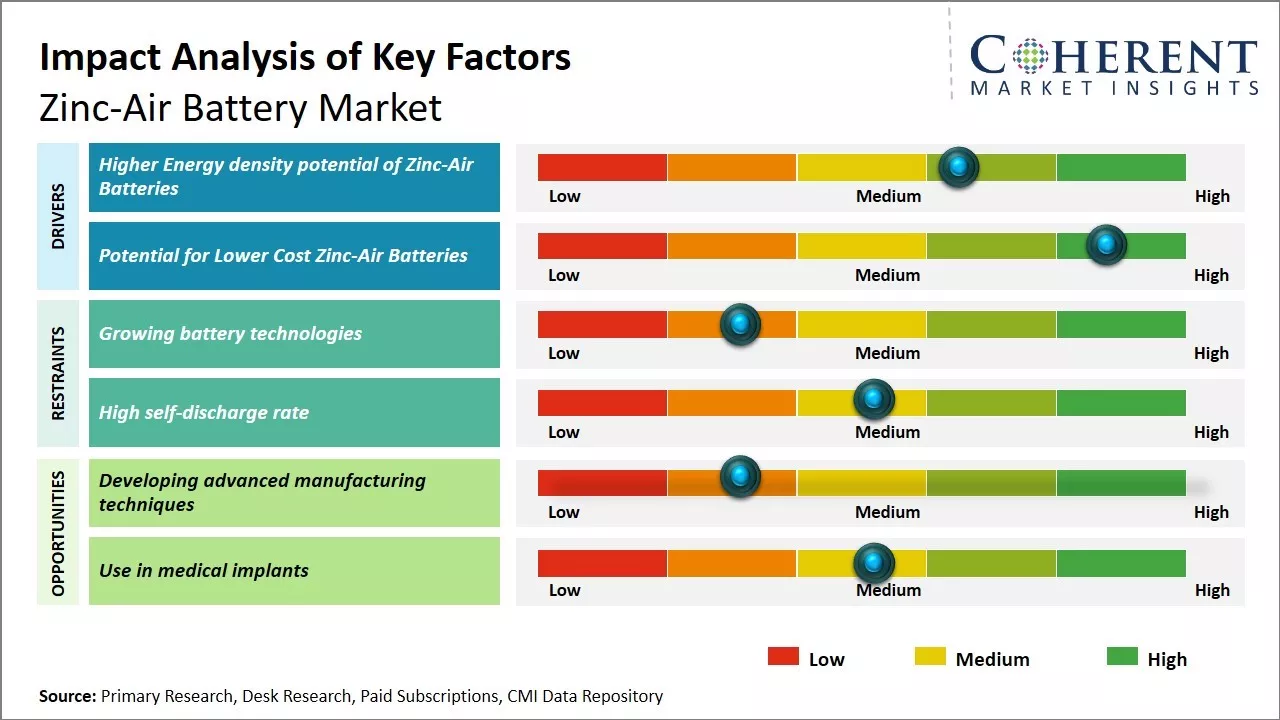
Discover market dynamics shaping the industry: Download Free Sample
The market is primarily driven by the increasing demand for zinc-air batteries in applications such as hearing aid devices, military applications, and other medical appliances due to advantages such as high energy density, safety, and longer shelf life. The zinc-air battery market is expected to witness significant growth over the forecast period. There is an increasing focus on the development of advanced and lightweight zinc-air batteries for applications such as electric vehicles and energy storage systems. The rising adoption of zinc-air batteries across IoT-enabled devices and electronics is also expected to support the market growth. However, high costs associated with zinc-air batteries may hamper the market expansion to some extent.
Higher Energy density potential of Zinc-air Batteries
Zinc-air batteries have the potential of providing higher energy density compared to other conventional battery technologies like lithium-ion batteries. The theoretical energy density of zinc-air batteries is over 1,000 watt-hours per kilogram which is significantly higher than lithium-ion batteries which have an energy density of around 250 watt-hours per kilogram. This higher energy density of zinc-air batteries is owing to the chemistry of the battery where zinc metal reacts with oxygen from air to produce electricity. Zinc metal provides a higher specific capacity compared to lithium. Furthermore, air used as the cathode provides unlimited capacity as oxygen can be replenished from atmospheric air during the recharging of the battery. The higher energy density means zinc-air batteries have the potential to power devices for longer duration compared to lithium-ion batteries of equivalent size and weight. For electric vehicles, this could mean longer driving range per charge. Similarly, for consumer electronics like phones, tablets, and drones, it could mean longer hours of usage per charge. Given the growing requirements for longer battery life in diverse applications, the higher energy density potential of zinc-air chemistry is an important driver boosting research and development in this battery technology.
Market Concentration and Competitive Landscape
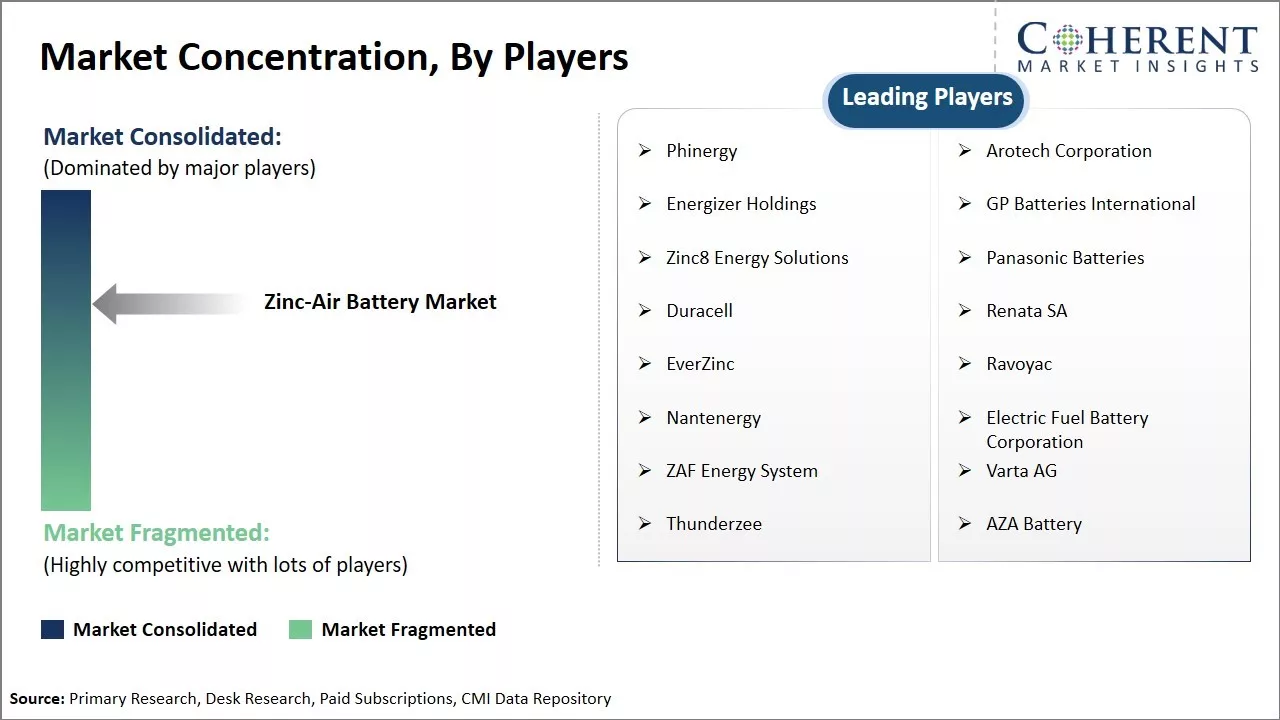
Get actionable strategies to beat competition: Download Free Sample
Potential for Lower Cost Zinc-air BatteriesZinc-air batteries have the promise of lower material cost compared to lithium-ion batteries. Zinc used in these batteries is widely available and inexpensive metal. For instance, in January 2021, The Tunderzee, a manufacturer, launched a new revolutionary zinc-air battery that is cheaper, lighter, safer, and more effective when compared to the lithium-ion battery. Its price fluctuations are also minimal globally. In contrast, lithium used in lithium-ion batteries have seen significant price volatility in recent years due to supply issues and growing demand. Furthermore, air used as the cathode provides an unlimited material at virtually zero cost unlike lithium or other cathode materials used in lithium-ion batteries. The abundant availability and relatively low and stable prices of zinc anode and air cathode can help address the growing need for lower cost battery solutions. The inherently lower material costs provide an impetus for stakeholders along the zinc-air battery.
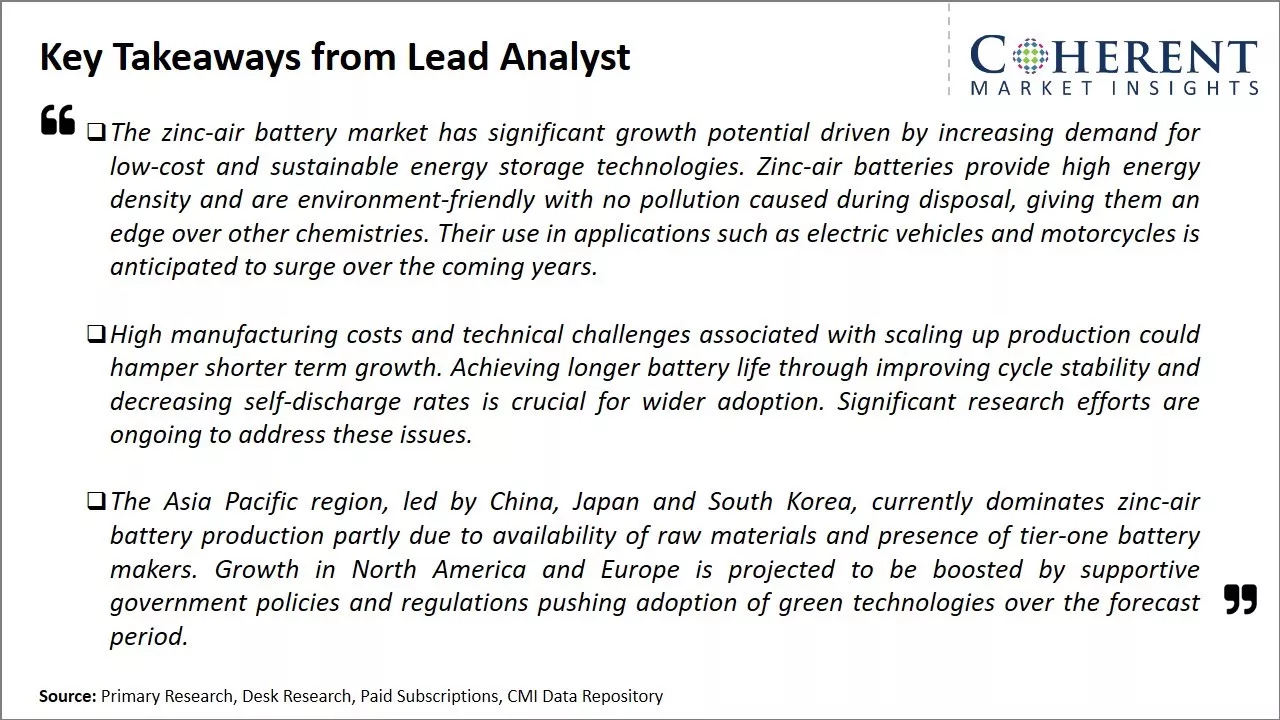
To learn more about this report, Download Free Sample
Market Challenges: Growing battery technologiesThe zinc-air battery market faces several challenges. Current battery technologies have significantly higher energy densities, making zinc-air less competitive for many applications. Manufacturing processes are complex and expensive, making zinc-air batteries difficult to produce at scale. Further, establishing reliable and extensive recharging infrastructure would be a major undertaking. Consumer awareness of this battery type remains quite low as well.
Market Opportunities: Developing advanced manufacturing techniques
The zinc-air battery market also presents opportunities. These batteries have exceptionally high theoretical energy densities and could store large amounts of renewable energy when paired with technologies like wind or solar. Developing advanced manufacturing techniques may help reduce production costs over time. Additionally, targeting niche markets requiring long lasting portable power first, like medical devices, could help raise awareness and adoption of zinc-air batteries before attempting to compete in larger mainstream fields.
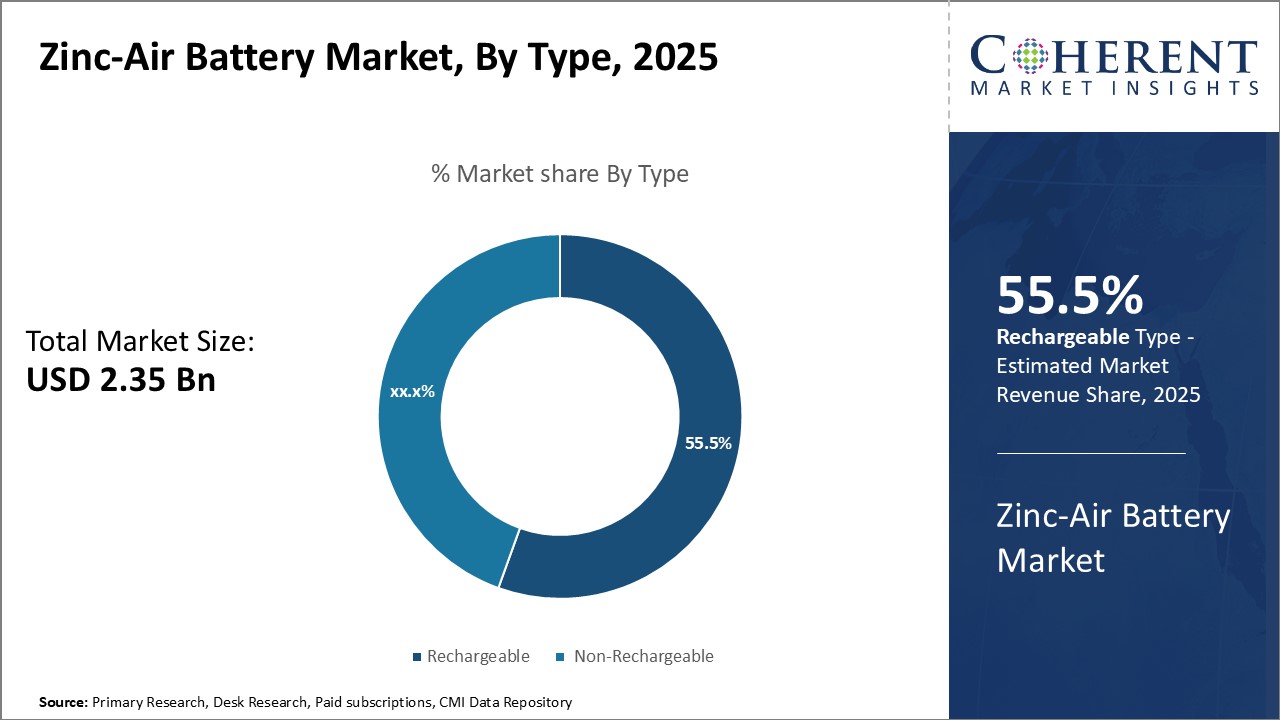
Discover high revenue pocket segments and roadmap to it: Download Free Sample
Insights, By Type: Convenience drives growth in the rechargeable segmentIn terms of type, rechargeable contributes 55.5% share of the market owing to its convenience and reusable nature. Rechargeable zinc-air batteries can be charged multiple times by replacing only the zinc anode, allowing consumers to avoid constant battery replacement. This replenishable design significantly reduces operating costs over the life of the batteries. Rechargeable batteries are also more eco-friendly as they produce less waste compared to non-rechargeable alternatives. Battery recyclers can recover zinc from used anodes to manufacture new batteries in a closed-loop system.
Insights, By Voltage Type: Ubiquity drives primary role of Up to 12V batteries
In terms of voltage type, the Up to 12 V segment contributes 39.8% of the market share owing to its broad compatibility. Batteries in the up to 12 V range can easily power a wide variety of small consumer devices that dominate the market, without complex voltage regulation circuitry. Products like flashlights, remote controls, toys, and wireless keyboards commonly use single 1.5 V, 3 V or 6 V batteries that fall under 12 V. The ubiquitous AA, AAA, C, D, and 9V battery forms mostly deliver less than 10 V and have established themselves as the default choice for portable electronics.
Insights, By Application: Unique benefits drive use in hearing aids
In terms of application, the hearing aids segment dominates due to various advantages of zinc-air batteries with 42.8% of the market share. Their relatively high energy density allows miniature cells to provide hearing devices with days of operation from a single battery. Zinc-air batteries maintain stable voltage until nearly fully discharged, delivering clear sound quality right until replacement. Their low self-discharge rate enables long shelf life without losing power even when stored unused for months. The unique air-based chemistry also provides a safe, inert response ideal for direct contact with human ears. Unlike leak-prone liquid cell designs, zinc-air batteries produce no messy spills or exposure to toxic materials if ruptured. The zinc anode self-seals on depletion, ensuring hearable devices remain fully enclosed. Manufacturers appreciate the design consistency of hearing aid batteries, which simplifies production handling and quality control. Consumers likewise benefit from the recognizable battery form that smoothly replaces in seconds without tools.
For instance, recent developments in hearing technology include the expansion of over-the-counter (OTC) hearing aids, which became legally available in the U.S. starting August 18, 2023, aiming to increase accessibility and lower costs for individuals experiencing hearing loss, and this is expected to drive the market growth.
Regional Insights
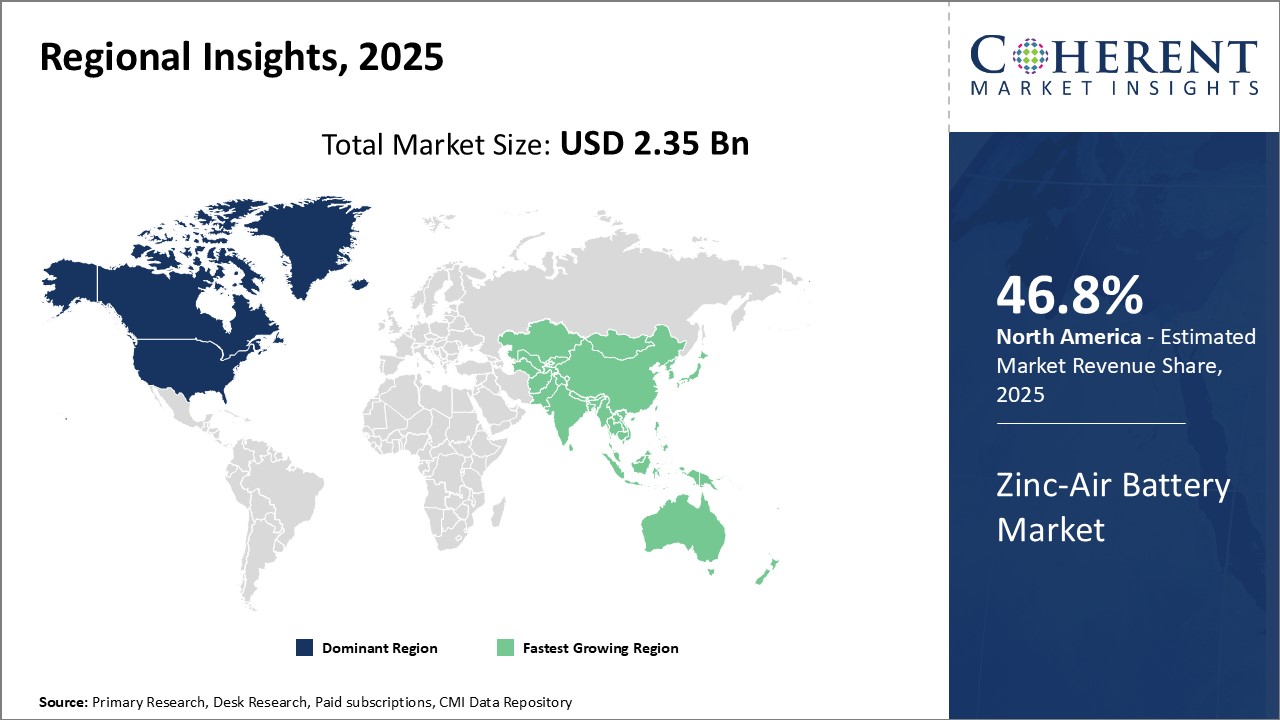
Need a Different Region or Segment? Download Free Sample
North America has been the dominant region in the zinc-air battery market for many years owing to strong presence of key manufacturers and high adoption of these batteries with 46.8% of the market share. The U.S. accounts for the major share given the strong industrial and transportation sector that relies on robust battery technology. Several U.S.-based companies such as Phinergy, Toshiba, and Pilenergy Inc have made advancements in developing optimal zinc-air fuel cell designs to enhance performance and lifecycle. Many state governors have initiated projects to utilize zinc-air batteries for power back-up applications like traffic signals, road signs, due to their high energy density and affordable costs. The growing trend towards electrification of vehicles and e-mobility space has further propelled research into improving zinc-air batteries.
The Asia Pacific region has emerged as the fastest growing regional market for zinc-air batteries. Countries like India, China, and Japan are aggressively focusing on battery technologies to further industrial and economic development. The electric bus market in China has picked up significantly over last few years, aided by government subsidies for cleaner mobility solutions. This has directly created demand for advanced battery packs and energizer units like zinc-air batteries specially designed for commercial vehicles. Indian Railways too have undertaken pilot projects to install rechargeable zinc-air batteries for powering signals across rail tracks. The inexpensive manufacturing costs and expertise in metals industry provides Asia Pacific an edge over other global locations. Strong export orientation of battery products from China and Japan has made Asia Pacific an attractive marketplace.
Market Report Scope
Zinc-Air Battery Market Report Coverage
| Report Coverage | Details | ||
|---|---|---|---|
| Base Year: | 2024 | Market Size in 2025: | USD 2.35 Bn |
| Historical Data for: | 2020 To 2024 | Forecast Period: | 2025 To 2032 |
| Forecast Period 2025 to 2032 CAGR: | 6.0% | 2032 Value Projection: | USD 3.54 Bn |
| Geographies covered: |
|
||
| Segments covered: |
|
||
| Companies covered: |
Phinergy, Arotech Corporation, Energizer Holdings, GP Batteries International, Zinc8 Energy Solutions, Panasonic Batteries, Duracell, Renata SA, EverZinc, Ravoyac, Nantenergy, Electric Fuel Battery Corporation, ZAF Energy System, Varta AG, Thunderzee, and AZA Battery |
||
| Growth Drivers: |
|
||
| Restraints & Challenges: |
|
||
Uncover macros and micros vetted on 75+ parameters: Get instant access to report
Zinc-Air Battery Industry News
- In January 2022, Zinc8 Energy Solutions announced a deployment agreement with Digital Energy Corporation to install a patented zinc-air energy storage system with Fresh Meadows LLC in Queens, New York. The agreement involves the installation of an innovative energy storage solution at Fresh Meadows Community Apartments in Queens, New York.
- In December 2021, Zinc8 Energy Solutions developed zinc-air batteries as an alternative to lithium-ion batteries, offering a 20,000-hour operating life and more than eight hours of storage. These batteries are designed for long-duration, high-capacity storage needs in applications such as wind or solar energy storage, commercial settings, and industrial backup to replace diesel generators. The company’s zinc-air batteries are safe, cost-effective, and do not experience thermal runaway like lithium-ion cells.
- In April 2021, Phinergy signed a memorandum of understanding with a green energy company, Doral in the field of an energy storage project, which will implement Phinergy’s zinc-air technology solutions. The memorandum states that Phinergy will be responsible for installation, operation, training, and replacement of equipment and maintenance of zinc-air technology and integration with Doral's energy facility.
- In January 2021, The Tunderzee, a manufacturer, launched a new revolutionary zinc-air battery that is cheaper, lighter, safer, and more effective when compared to the lithium-ion batteries
*Definition: The zinc-air battery market consists of companies involved in the development, manufacturing, and sale of zinc-air batteries. Zinc-air batteries use zinc as the anode, oxygen in the air as the cathode, and an alkaline electrolyte. They have a high energy density and are economical compared to other primary batteries. Zinc-air batteries can power medical devices, hearing aids, portable electronics, and other products requiring small, long-lasting power sources.
Market Segmentation
- Type Insights (Revenue, USD Bn & Units, 2020 - 2032)
- Non-Rechargeable
- Rechargeable
- Voltage Type Insights (Revenue, USD Bn & Units, 2020 - 2032)
- Up to 12 V
- 12 V to 36 V
- More than 36 V
- Application Insights (Revenue, USD Bn & Units, 2020 - 2032)
- Hearing Aids
- Military Devices
- Others (Railway & Road Traffic Signaling, etc.)
- Regional Insights (Revenue, USD Bn & Units, 2020 - 2032)
- North America
- U.S.
- Canada
- Latin America
- Brazil
- Argentina
- Mexico
- Rest of Latin America
- Europe
- Germany
- U.K.
- Spain
- France
- Italy
- Russia
- Rest of Europe
- Asia Pacific
- China
- India
- Japan
- Australia
- South Korea
- ASEAN
- Rest of Asia Pacific
- Middle East & Africa
- GCC Countries
- Israel
- Rest of Middle East & Africa
- North America
- Key Players Insights
- Phinergy
- Arotech Corporation
- Energizer Holdings
- GP Batteries International
- Zinc8 Energy Solutions
- Panasonic Batteries
- Duracell
- Renata SA
- EverZinc
- Ravoyac
- Nantenergy
- Electric Fuel Battery Corporation
- ZAF Energy System
- Varta AG
- Thunderzee
- AZA Battery
Share
Share
About Author
Yash Doshi is a Senior Management Consultant. He has 12+ years of experience in conducting research and handling consulting projects across verticals in APAC, EMEA, and the Americas.
He brings strong acumen in helping chemical companies navigate complex challenges and identify growth opportunities. He has deep expertise across the chemicals value chain, including commodity, specialty and fine chemicals, plastics and polymers, and petrochemicals. Yash is a sought-after speaker at industry conferences and contributes to various publications on topics related commodity, specialty and fine chemicals, plastics and polymers, and petrochemicals.
Missing comfort of reading report in your local language? Find your preferred language :
Transform your Strategy with Exclusive Trending Reports :
Frequently Asked Questions
EXISTING CLIENTELE
Joining thousands of companies around the world committed to making the Excellent Business Solutions.
View All Our Clients
